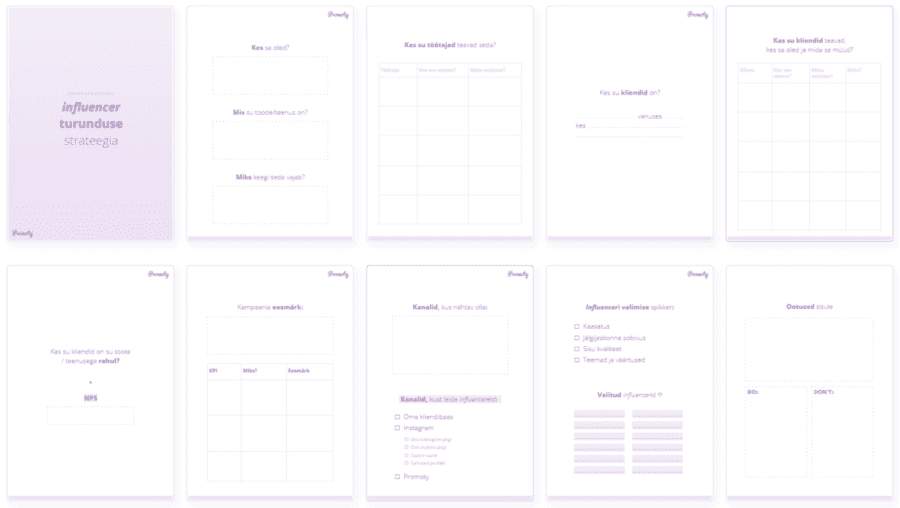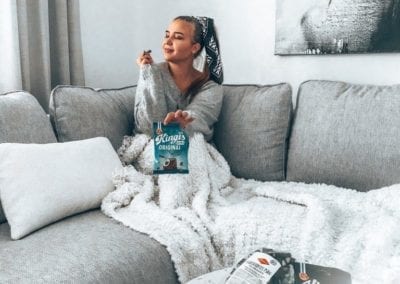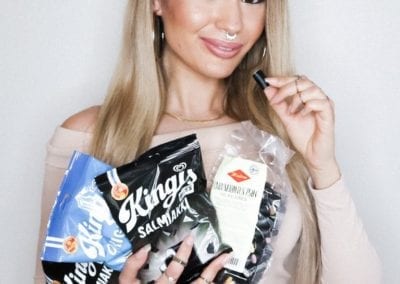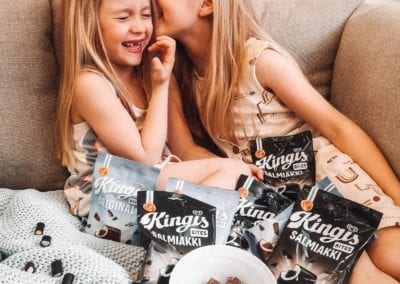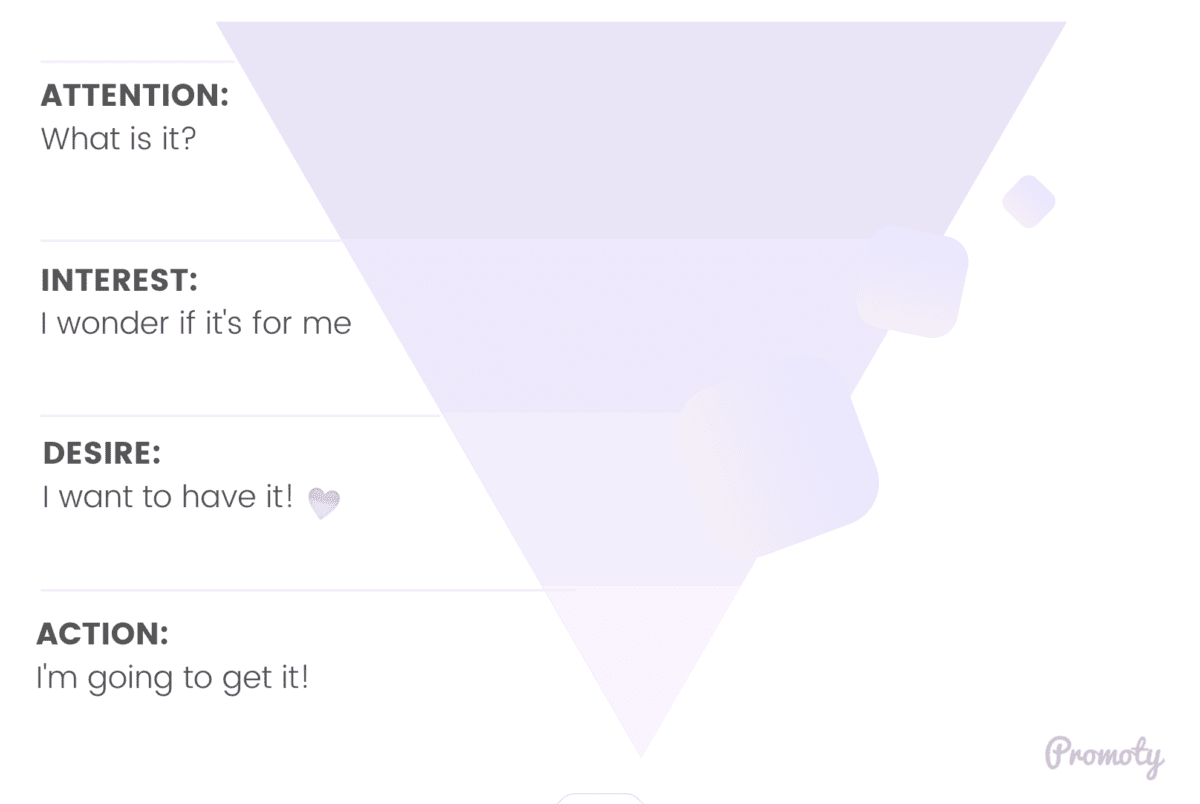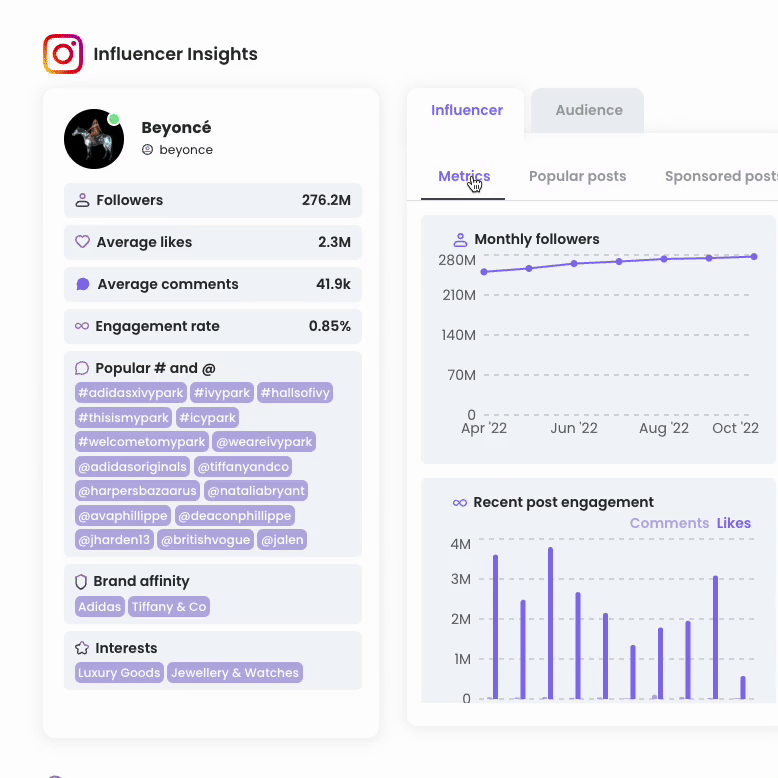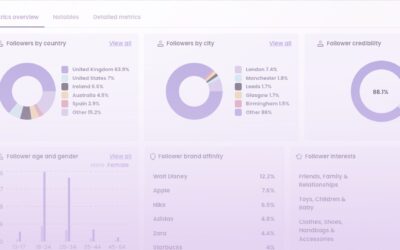Over the years, more than 5,000 influencer marketing campaigns have been run on our platform. These include campaigns for both large and small brands, more and less successful campaigns, and campaigns in both local and foreign markets. These thousands of campaigns have also revealed some marketing mistakes that marketers tend to make.
Let’s see what they are and how to avoid them! 👇🏼
MARKETING MISTAKE 1: Random influencer marketing bursts
Influencer marketing is a relatively new field of marketing. Therefore, many marketers do not yet have the experience to engage influencers in their marketing in a strategic and results-effective way.
Oftentimes, marketers do two or three one-off collaborations to start with, and if they don’t see the results right away, decide that influencer marketing doesn’t work for them.
“A few years ago, when there were significantly fewer collaboration posts on social media, short-term influencer campaigns worked well, but not anymore,” explained Anni Rahula, Head of Campaign Success at Promoty. “As nowadays there is so much more noise, a one-off collaboration between all promotional posts may not stand out – let alone get the message across.”
Influencer marketing is an effective tool for marketing, but it doesn’t work in itself – just as a hammer doesn’t work if you hold it in the wrong way.
How to do it better:
Take a long-term approach here: test different messages and approaches, measure and optimize to get better results over time. Exactly how you do your PPC ads!
Long-term influencer partnerships not only require less time from the marketer but also bring better results. As consumers need multiple contact points to make a purchase decision, they also have a greater impact on results.
Effective influencer marketing starts with a thoughtful strategy. For this, we have created an influencer marketing strategy worksheet, which includes setting a clear message, defining the purpose and target group of the campaign, selecting channels, and creating your “ideal influencer” checklist. Actually, this is the same framework that we use for creating influencer marketing strategies for our customers. Download it for free! 🤍
MARKETING MISTAKE 2: The goal of the campaign is not clear
Influencer marketing can be a great tool for encouraging word-of-mouth marketing, raising brand awareness, shaping brand image, or increasing sales – but not everything at once.
Suppose an influencer tries to direct their followers to a brand’s website, follow their Instagram page, and at the same time, participate in a giveaway. In that case, the follower will most likely get confused instead of following the call to action, and the collaboration will not serve its purpose.
The goal of the campaign determines the choice of influencers, the structure of the collaboration, the selection of KPI-s, and the evaluation of results – the same aspects that are the basis of a successful influencer marketing strategy! If the goal is not set, the whole campaign is a big mess.
How to do it better:
Start the campaign’s planning by clearly formulating the goal: is it strengthening the brand, launching a new product, supporting the discount campaign, increasing the number of Instagram followers, or something else.
Secondly, make sure that the goal is clearly stated in the campaign brief. This way, the influencer knows what is the main goal of the collaboration and can write their call to action accordingly.
.
Let’s look at a case study from our platform
When launching a new product line, Finnish candy brand Halva run a micro-influencer campaign on Promoty to 1) raise awareness of the new product line and 2) get more followers for the brand’s Instagram page.
To reach the campaign goals, they launched giveaways with 99 local influencers. Each creator got a selection of products to throw a giveaway. To participate, their followers had to follow both the influencer and the brand; therefore, both parties got new followers!
In total, the campaign reached 380 000+ people, and the brand got 6852 new followers on Instagram – in a small market like Finland, those numbers are pretty impressive!
Micro-influencer marketing case study: Halva’s Kingis Product Launch
Goal: Engage influencers to get additional visibility for Halva’s new product launch
Reward: Product (box of candies)
Posts: 99
Reach: 389 845
Likes: 28 826
CPE: 0,02€
New followers: 6852
👉🏼 Read more: 7 inspiring micro-influencer case studies
MARKETING MISTAKE 3: Focusing on sales too early
We’ve seen campaigns on the platform where the campaign brief is “to make posts that bring us sales”. Well, it does not work like this. If the consumer has never heard about the brand before, they probably won’t do the purchase right away – no matter which marketing channel are you using.
How to do better:
In marketing theory, the AIDA model shows us that first, you need to get consumers’ attention, then their interest, from which the desire grows, and finally, the desired action.
That does not happen with one influencer collaboration: studies have shown that, on average, it takes the consumer 8 touch points to make a purchase decision.
Nobody likes to be sold on social media – instead, we seek inspiration, entertainment, or learning something useful. Thus, most of the social media marketing should play in the awareness and interest generation phase. Once the foundation is laid, consumers can be encouraged to buy with sales offers.
In the case of an unknown brand, it’d be smart to launch the first campaigns to increase brand awareness, create interest and desire. After that, you can run a campaign where the same influencers share a discount code to motivate interested followers to purchase. Not to mention that using personal discount codes is also an amazing tool for measuring influencer marketing results!
MARKETING MISTAKE 4: Choosing influencers randomly
Choosing the right collaboration partners is one of the most important decisions in influencer marketing: in many cases, it determines the campaign’sresults.
Unfortunately, we’ve noticed that marketers often choose influencers based on first impressions without delving into their values, previous collaborations, or determining who their audience is. In this case, mistakes might happen – such as inviting someone who has a long-term collaboration with a fast-fashion brand and who buys disposable coffee cups on a daily basis, to an environmental awareness campaign.
Professional influencers, of course, do not accept campaigns that don’t match their values. However, micro-influencers with less experience might do that – and in this case, the dissonance between the influencer’s and brand’s values might cause more harm than good.
It may also be the case that a seemingly local influencer has an audience from elsewhere, which means that a campaign targeting the local market will not reach local consumers.
How to do better:
When choosing influencers, make sure to open the influencer’s Instagram profile to delve into its value and previously shared content: is this the person you want to represent your brand?
A good tip is to create your own “ideal influencer” checklist and follow it. For example, it could include:
◻️ influencer’s values – to match the brand values;
◻️ influencer’s relationship with the brand – for example, if they are a long-term user;
◻️ followers demographics (gender, age, location) – to match the brand’s target audience;
◻️ quality of their content: visuals, captions, previous collaborations;
◻️ other criteria that are important to you.
The choice of influencers also depends on the purpose of the campaign: if a brand wants to get visuals on its social media channels, the quality of the posted photos plays an important role. If the main goal is to reach a certain target group, the audience demographics is the most important thing to look at.
On Promoty, influencers write a short “cover letter” when applying to the campaign. This is also something to take into consideration: if it’s well thought out and contains a personal touch with the brand, you can also expect an authentic and meaningful collaboration post.
MARKETING MISTAKE 5: Not giving enough guidelines
Another aspect of a successful influencer marketing campaign is the campaign brief.
There are two extremes here: giving the influencer too strict instructions can deprive the influencer of his or her authenticity and personality, and the post will feel very commercial. Furthermore, sometimes brands add so much information to the campaign brief that the influencer cannot pick out the important part.
On the other hand, if a brand does not clearly communicate its expectations, the purpose of the campaign, and doesn’t give the necessary background information, the collaboration post might not meet the brand’s goals.
“Professional influencers get to know the brand, especially in long-term co-operation, but they are not mind readers,” Anni Rahula explained. “Of course, the creative freedom of influencers should not be over-controlled – but insufficient information can also be the cause of poor performance.”
How to do it better:
The ideal campaign brief is clear, compelling, and as short as possible, yet containing the necessary information:
◻️ short intro of the brand or product;
◻️ structure or idea of co-operation;
◻️ purpose of the campaign;
◻️ which influencers are being searched for;
◻️ DOs & DON’Ts.
Writing an influencer campaign brief is similar to writing ad copy: important information should be displayed right at the beginning of the brief. As already discussed, it’s also crucial to clearly state the purpose of the campaign – that helps the creator choose the right CTA.
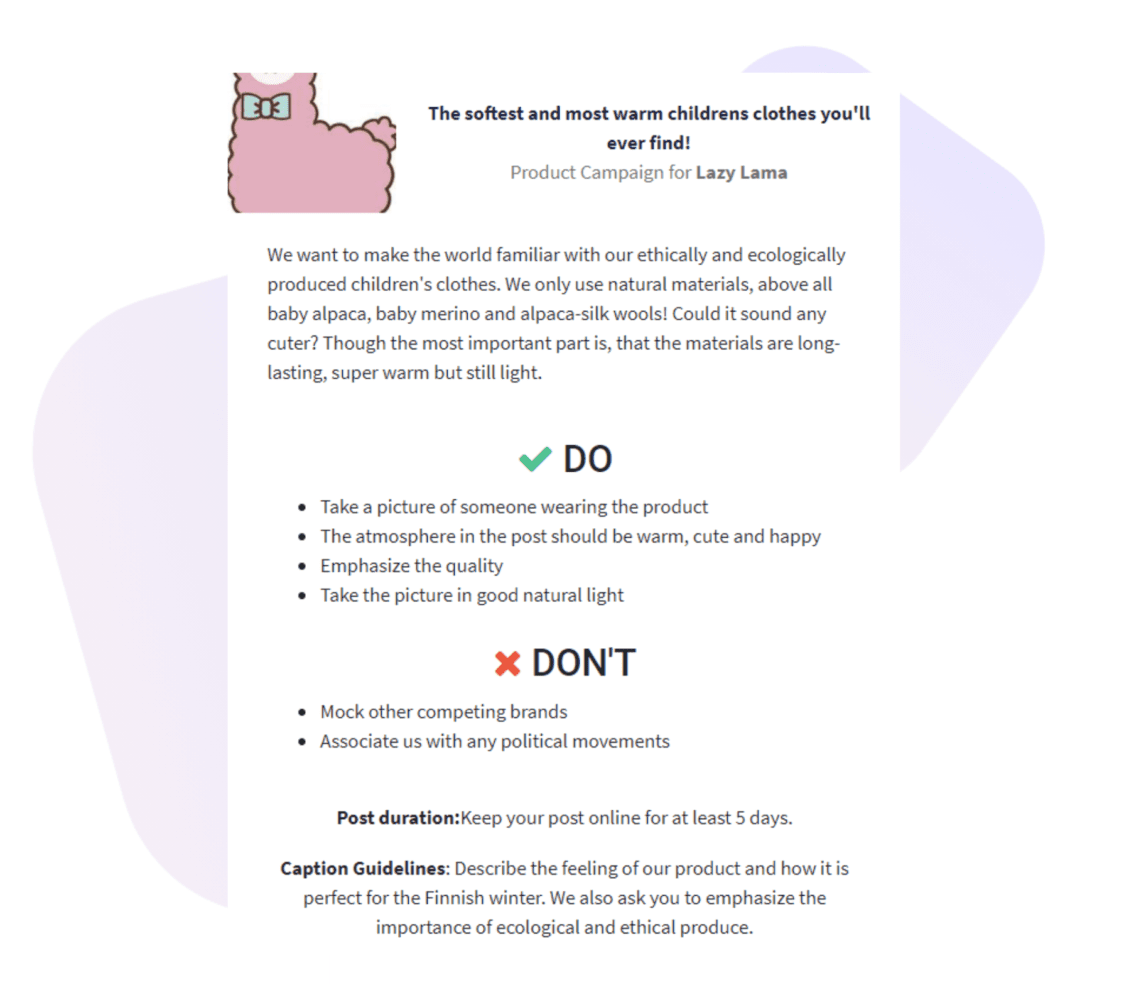
A campaign brief of a kids’ apparel brand
MARKETING MISTAKE 6: Lack of communication
We often tend to blame influencers for lack of communication – but in reality, there are also some things that marketers could do better. Here are some common errors:
• On Promoty, some marketers do not approve the uploaded content – which leaves the influencer in a weird situation where they don’t know if the collaboration is still valid.
• Shipping of the products is delayed, which means that the influencer does not have enough time to create the content.
• Influencer is not provided with sufficient information about product shipments, campaign deadlines, allowed personal promotional codes, and other campaign details.
• After the end of the collaboration, no feedback is given to the influencer. In this case, the influencer does not know if the brand representative was satisfied with the collaboration or if something could have been done differently.
How to do better:
As with any relationship, the responsibility for good communication lies with both parties: the marketer should also be proactive.
• If you have submitted content in your campaign, purchase it or request changes. If you’re planning to purchase the content a little later, let the influencer know.
• If a campaign is delayed or, for some reason, a post is no longer needed, let your collaboration partner know in a timely manner and explain the situation.
• Always make sure that the influencer has enough time to create the content. For example, if the shipping of the products is delayed, you might need to extend the campaign deadline to give the influencer time to create the content.
• If you promised to give influencers a personal promotional code, don’t forget to share this information with the influencers.
We’ve noticed that some marketers on the Promoty platform write sweet welcome messages to the accepted influencers, shortly introducing themselves and the next steps. This is also something that helps to build strong relationships with influencers.
• After the collaboration, give feedback to the creator – especially with the personal discount codes where you knew exactly how many sales each influencer brought. Constructive criticism helps them to get better, while positive feedback encourages them to continue.
MARKETING MISTAKE 7: Not using influencers’ content
Our Estonian Country Manager Mirjam-Johanna Loddes conducted a small study of the collaborations made in Estonia, analyzing the collaborations of content creators in 6 different fields over a 3-month period.
It turned out that only half of these brands used the images created by the influencers in their Instagram account. However, the brands that did so had twice as many likes of their posts as the rest of their posts! Additionally, when the brand introduced and highlighted this collaboration on their account, it felt sincere and transparent for the followers, not so much as purchased advertising.
How to do better:
Based on these numbers, you can say that it’s definitely worth using influencers’ photos on your social media! In addition to being eye-catching, trendy and original, the content created by influencers is also much more engaging.
For example, the Danish jewellery brand Zilver ran a Promotys campaign just to get product photos for its social media account. Here is their Instagram profile before and after using Promoty!
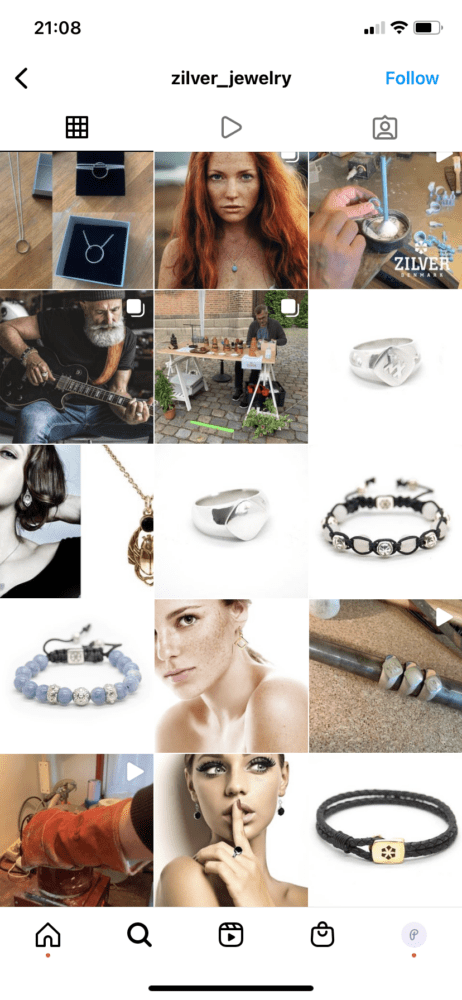
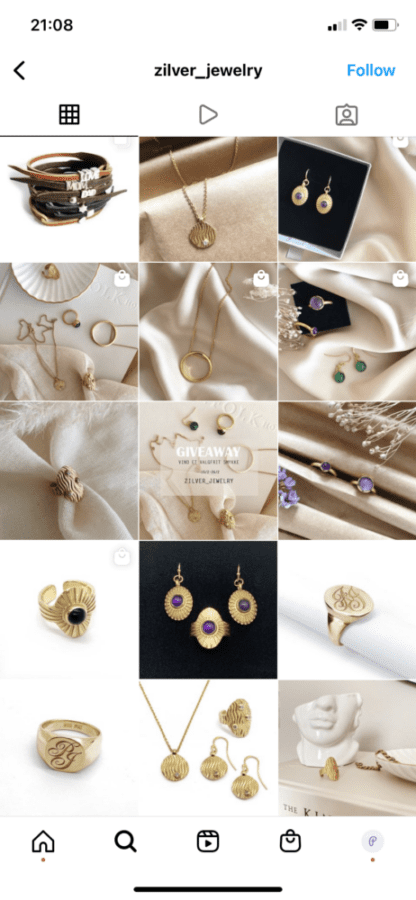
Of course, having an aesthetic Instagram feed isn’t the most important thing – but when someone visits your profile, the first impression will determine if they will delve into the brand’s content.
MARKETING MISTAKE 8: Not marking the sponsored content
We ran a survey among Estonian marketers and found out that only 14% of the marketers always make sure that the collaboration posts are marked correctly, and 21% don’t pay attention to it at all.
“I’ve felt resistance from both sides – sometimes people fear that the post will not work as well when it’s marked as an advertisement,” said Anni. “This is absolutely not true. From my experience, I can confirm that a beautiful visual with an authentic and emotionally written advertising message goes much further than a post with a hidden advertisement.”
How to do it better:
In this case, both parties should take responsibility. As a marketer, make sure to ask your collaboration partners to mark the collaboration post according to the local law. To avoid miscommunications, it would be smart to mention your expectations in the first campaign brief.
When you run a campaign on Promoty, the system checks using the local #adveritising hashtag in all the collaboration posts and stories – which makes it a little easier!
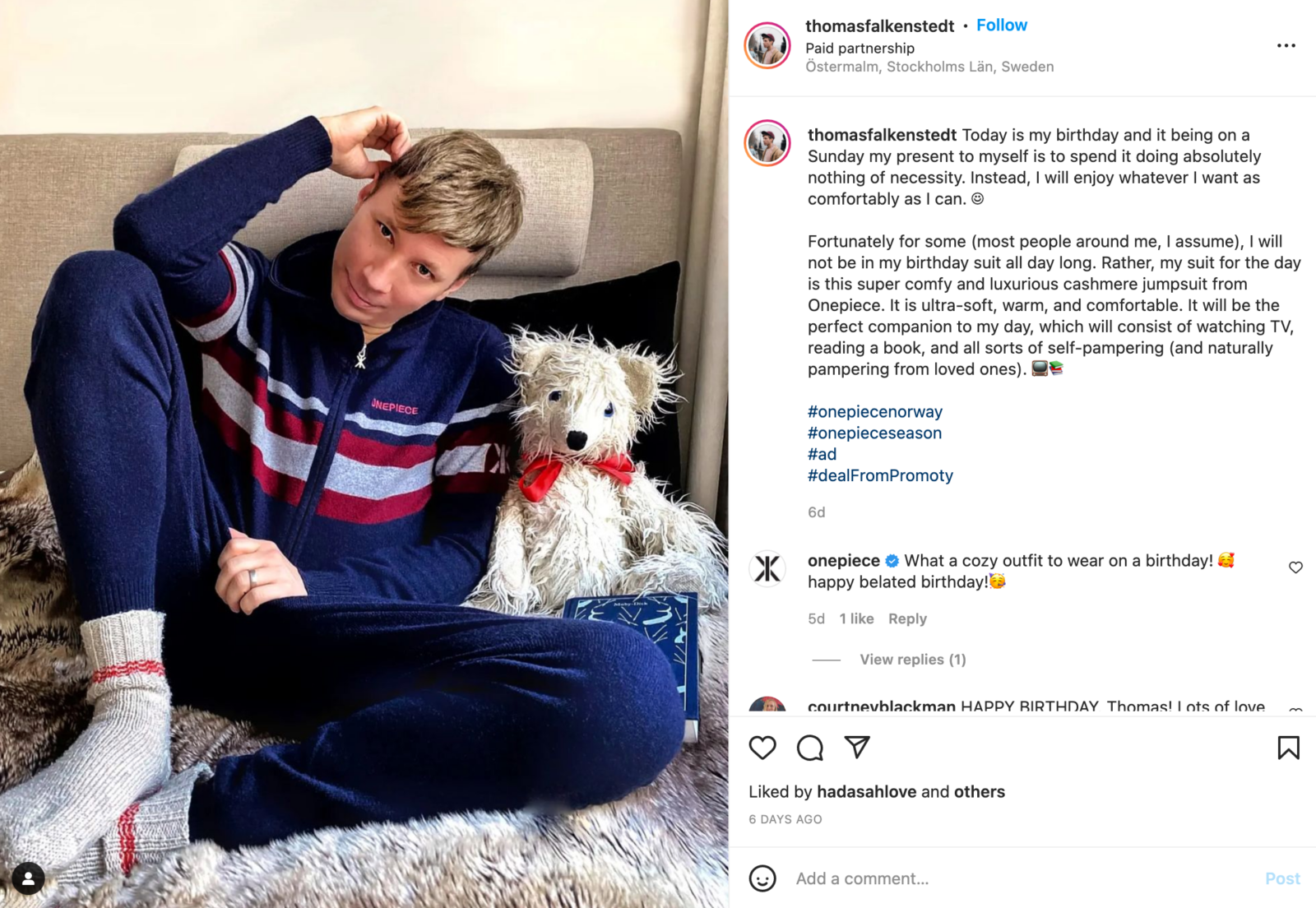
@thomasfalkenstedt x Onepiece collaboration post
MARKETING MISTAKE 9: Doing everything manually
The most common way for managing influencer collaborations is email inbox: something we found out in the same survey we ran among Estonian marketers. 46% agreed they use the mailbox, and 21% use spreadsheets to keep track of their ongoing collabs; the rest use influencer marketing platforms.
Of course, it’s possible to search for influencers on Instagram – it just takes a lot of time. For example, when we launched Promoty, it took us about 40 hours to find the first 100 influencers. Using the Promoty platform, it would now take about ten minutes.
The same applies to 1:1 deal negotiations, gathering the shipping information and shipping the products, signing contracts, collecting payout information and making payments, asking for screenshots after posting, and manually entering data into Excel to get an overview of the campaign results – this is definitely a bigger cost than paying 20% of the platform fee.
The charm of an influencer management platform is that you can manage all your content creators, collaborations, posted content, payments, and campaign results in one place.
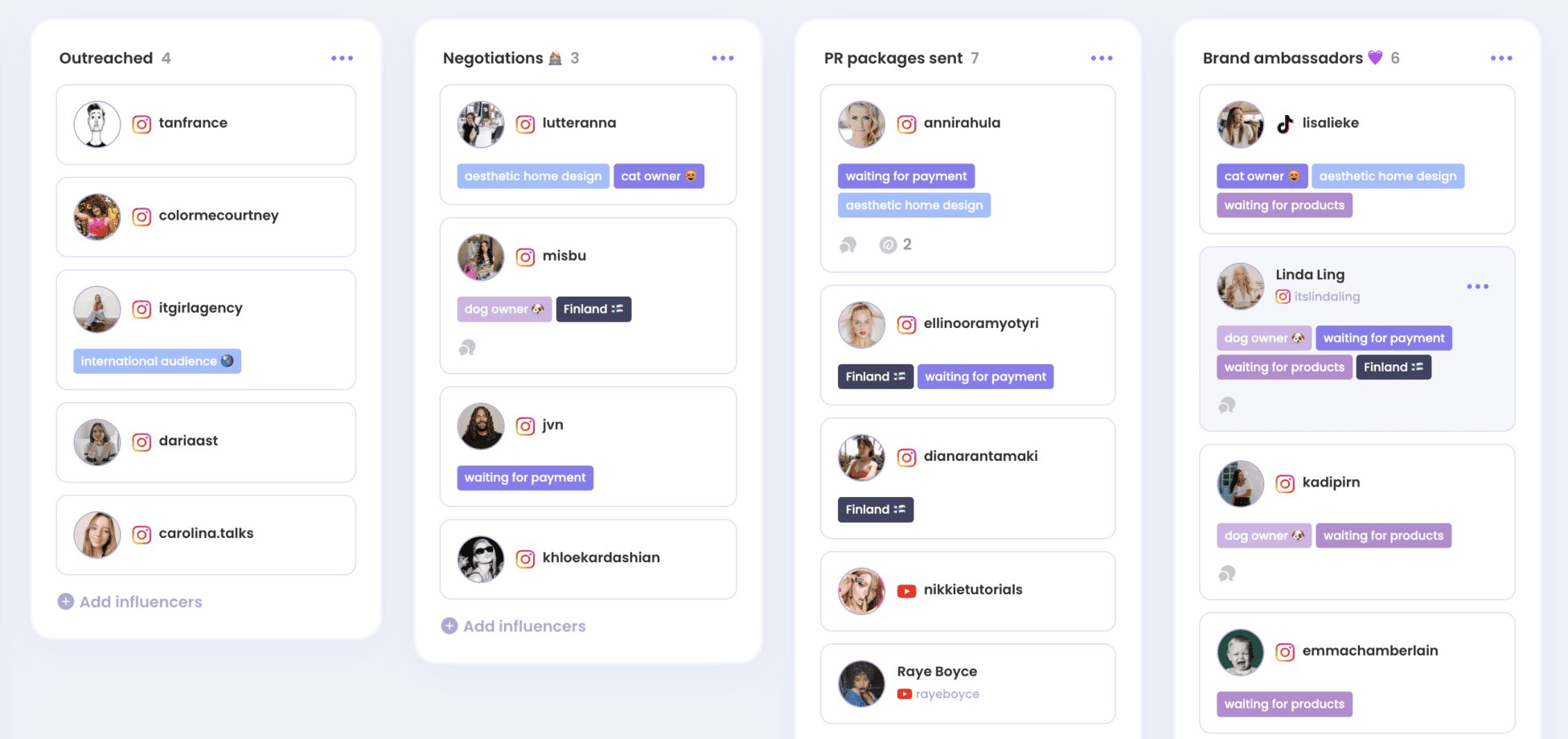
What is it all to do with us?
Promoty is an influencer relationship management platform that allows brands to manage all their (potential) influencers, collaborations, chats, and content in one place. Here’s a short demo video of how it works! 👇🏼
Using Promoty’s Influencer Discovery, you can search for influencers worldwide, filtering by their social media metrics or audience data. Additionally, you can see detailed account insights for every influencer – which helps you to find the right TikTok and Instagram influencers for your brand. 🤍
Additionally, you can use our influencer CRM to manage your current and potential collaboration partners, detect branded content, and chat with influencers. Create a free account to get started!
